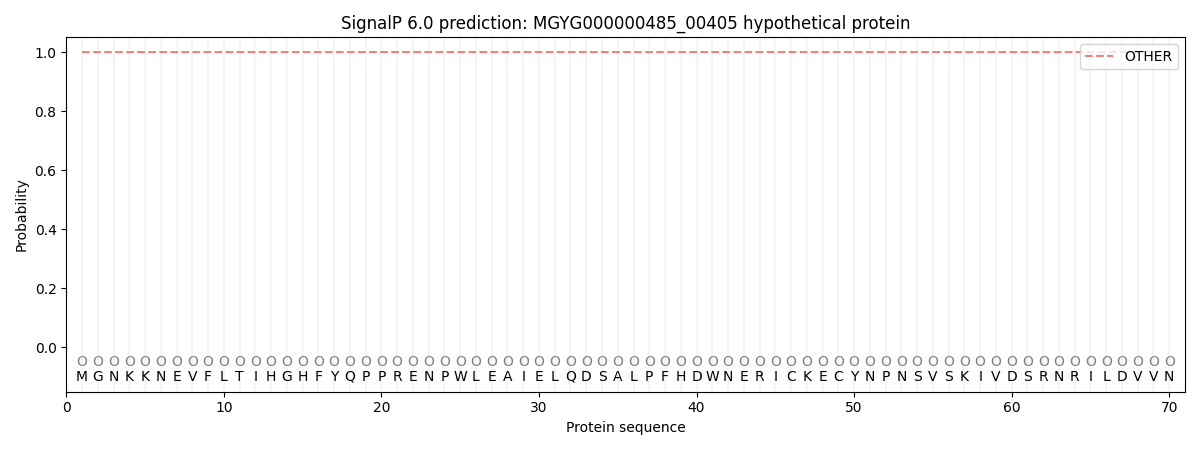You are browsing environment: HUMAN GUT
CAZyme Information: MGYG000000485_00405
You are here: Home > Sequence: MGYG000000485_00405
Basic Information |
Genomic context |
Full Sequence |
Enzyme annotations |
CAZy signature domains |
CDD domains |
CAZyme hits |
PDB hits |
Swiss-Prot hits |
SignalP and Lipop annotations |
TMHMM annotations
Basic Information help
| Species | Zag1 sp900767135 | |||||||||||
|---|---|---|---|---|---|---|---|---|---|---|---|---|
| Lineage | Bacteria; Cyanobacteria; Vampirovibrionia; Gastranaerophilales; Gastranaerophilaceae; Zag1; Zag1 sp900767135 | |||||||||||
| CAZyme ID | MGYG000000485_00405 | |||||||||||
| CAZy Family | GH57 | |||||||||||
| CAZyme Description | hypothetical protein | |||||||||||
| CAZyme Property |
|
|||||||||||
| Genome Property |
|
|||||||||||
| Gene Location | Start: 74831; End: 77332 Strand: + | |||||||||||
CAZyme Signature Domains help
| Family | Start | End | Evalue | family coverage |
|---|---|---|---|---|
| GH57 | 56 | 326 | 4.3e-56 | 0.6971279373368147 |
CDD Domains download full data without filtering help
| Cdd ID | Domain | E-Value | qStart | qEnd | sStart | sEnd | Domain Description |
|---|---|---|---|---|---|---|---|
| cd10797 | GH57N_APU_like_1 | 0.0 | 9 | 339 | 1 | 327 | N-terminal putative catalytic domain of mainly uncharacterized prokaryotic proteins similar to archaeal thermoactive amylopullulanases; glycoside hydrolase family 57 (GH57). This subfamily of mainly uncharacterized bacterial proteins, shows high sequence homology to GH57 archaeal thermoactive amylopullulanases (APU, E.C 3.2.1.1/41). Thermoactive APUs are type II pullulanases with both pullulanolytic and amylolytic activities. They have an acid pH optimum and the presence of Ca2+ might increase their activity, thermostability, and substrate affinity. |
| pfam12055 | DUF3536 | 2.92e-132 | 347 | 630 | 1 | 284 | Domain of unknown function (DUF3536). This presumed domain is functionally uncharacterized. This domain is found in bacteria and archaea. This domain is typically between 274 to 285 amino acids in length. This domain is found associated with pfam03065. |
| cd01022 | GH57N_like | 8.80e-51 | 12 | 334 | 4 | 312 | N-terminal catalytic domain of heat stable retaining glycoside hydrolase family 57. Glycoside hydrolase family 57(GH57) is a chiefly prokaryotic family with the majority of thermostable enzymes coming from extremophiles (many of these are archaeal hyperthermophiles), which exhibit the enzyme specificities of alpha-amylase (EC 3.2.1.1), 4-alpha-glucanotransferase (EC 2.4.1.25), amylopullulanase (EC 3.2.1.1/41), and alpha-galactosidase (EC 3.2.1.22). This family also includes many hypothetical proteins with uncharacterized activity and specificity. GH57s cleave alpha-glycosidic bonds by employing a retaining mechanism, which involves a glycosyl-enzyme intermediate, allowing transglycosylation. |
| cd10796 | GH57N_APU | 1.43e-17 | 74 | 324 | 47 | 303 | N-terminal catalytic domain of thermoactive amylopullulanases; glycoside hydrolase family 57 (GH57). Pullulanases (EC 3.2.1.41) are capable of hydrolyzing the alpha-1,6 glucosidic bonds of pullulan, producing maltotriose. Amylopullulanases (APU, E.C 3.2.1.1/41) are type II pullulanases which can also degrade both the alpha-1,6 and alpha-1,4 glucosidic bonds of starch, producing oligosaccharides. This subfamily includes GH57 archaeal thermoactive APUs, which show both pullulanolytic and amylolytic activities. They have an acid pH optimum and the presence of Ca2+ might increase their activity, thermostability, and substrate affinity. Besides GH57 thermoactive APUs, all mesophilic and some thermoactive APUs belong to glycoside hydrolase family 13 with catalytic features distinct from GH57. This subfamily also includes many uncharacterized proteins found in bacteria and archaea. |
| cd10793 | GH57N_TLGT_like | 1.75e-11 | 40 | 312 | 16 | 259 | N-terminal catalytic domain of 4-alpha-glucanotransferase; glycoside hydrolase family 57 (GH57). 4-alpha-glucanotransferase (TLGT, EC 2.4.1.25) plays a key role in the maltose metabolism. It catalyzes the disproportionation of amylose and the formation of large cyclic alpha-1,4-glucan (cycloamylose) from linear amylose. TLGT functions as a homodimer. Each monomer is composed of two domains, an N-terminal catalytic domain with a (beta/alpha)7 barrel fold and a C-terminal domain with a twisted beta-sandwich fold. Some family members have been designated as alpha-amylases, such as the heat-stable eubacterial amylase from Dictyoglomus thermophilum (DtAmyA) and the extremely thermostable archaeal amylase from Pyrococcus furiosus(PfAmyA). However, both of these proteins are 4-alpha-glucanotransferases. DtAmyA was shown to have transglycosylating activity and PfAmyA exhibits 4-alpha-glucanotransferase activity. |
CAZyme Hits help
| Hit ID | E-Value | Query Start | Query End | Hit Start | Hit End |
|---|---|---|---|---|---|
| AOR38251.1 | 0.0 | 1 | 833 | 1 | 833 |
| BCS53554.1 | 2.30e-241 | 5 | 779 | 4 | 774 |
| ACM19576.1 | 1.33e-240 | 7 | 779 | 2 | 767 |
| AFM25144.1 | 5.48e-236 | 7 | 818 | 2 | 805 |
| QHT67801.1 | 1.89e-232 | 9 | 818 | 6 | 808 |
Swiss-Prot Hits help
SignalP and Lipop Annotations help
This protein is predicted as OTHER

| Other | SP_Sec_SPI | LIPO_Sec_SPII | TAT_Tat_SPI | TATLIP_Sec_SPII | PILIN_Sec_SPIII |
|---|---|---|---|---|---|
| 1.000059 | 0.000000 | 0.000000 | 0.000000 | 0.000000 | 0.000000 |
